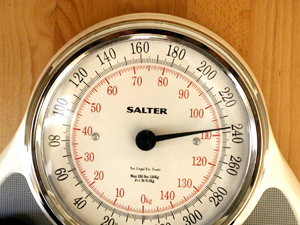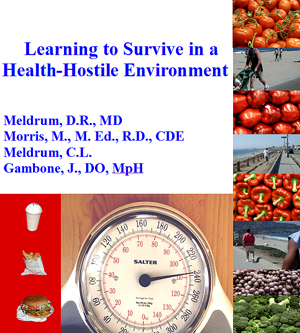Lifechoicesandfertility.com
Weight and Fertility
Abnormalities of body weight can have dramatic effects on ovulation. A normal body mass index (check your BMI) is between 18.5 and 24.9. Low body weight, particularly when combined with stress, can cause menses and ovulation to stop due to suppression of the hormones normally activating the ovaries.  On the other end of the scale, excess weight can cause menses and ovulation to cease due to the many complex effects of the extra weight, including increased levels of insulin. In both of these instances, ovulation and normal fertility can often be achieved just by normalizing your weight. In fact for women with excess weight, ovulation and pregnancy may occur by losing as little as 10% of your current weight, without getting back down to a fully normal weight.
On the other end of the scale, excess weight can cause menses and ovulation to cease due to the many complex effects of the extra weight, including increased levels of insulin. In both of these instances, ovulation and normal fertility can often be achieved just by normalizing your weight. In fact for women with excess weight, ovulation and pregnancy may occur by losing as little as 10% of your current weight, without getting back down to a fully normal weight.
A BMI in the normal range is best
Excess body weight has major effects on ovulation but only recently has it been fully realized that extra weight also decreases the chance of pregnancy and increases the chance of miscarriage even if a woman is ovulating. With IVF, obesity was found to increase miscarriage by about 25% (Kawwass, 2016). In a study* of almost 50,000 cycles of IVF, women were classified as overweight, or having class I, II, or III obesity. In the table below, the odds of pregnancy and live birth are expressed as decreased chances of achieving a pregnancy or live birth and the increased chance to deliver very prematurely compared to women whose weight is normal (BMI 18.5-24.9):
Normal 18.5- 24.9 |
Overweight BMI 25-29.9 |
Class I BMI 30-34.9 |
Class II BMI 35-39.9 |
Class III BMI > 39.9 |
| Pregnancy* | - 3% | - 14% | - 26% | - 41-53% |
| Live Birth* | - 10% | - 25% | - 34% | - 39 -229% |
| Preterm birth < 32 weeks** |
+ 26% | + 52% | + 59% |
(*Luke B, 2011)
The chance of suffering a stillbirth for obese women was two-fold higher*. You can see from these results that as weight increases the chance of a successful birth progressively falls. The most prominent effect occurs when the BMI is over 35, when women are fully a third less likely to achieve a live birth. Even with a successful birth, the odds of delivering before 32 weeks, which is quite premature, increases by over 25% when the BMI is over 30 and by over 50% when the BMI is over 35. Such early delivery can lead to a marked increase of the chance of the newborn not surviving or having very significant health problems or permanent handicaps.
For reasons that are not understood, these effects are greater in non-white (Asian, Latino and African-American) compared to white women (Luke 2011b). The chance of failing to give birth was 86% higher in non-white compared to white women who were obese (Luke, 2017). For prematurity, African-American women are at even greater risk, particularly with multiple pregnancy. Weight control is therefore particularly important in all non-white women having IVF. Because of all of these risks, transfer of a single embryo should be considered whenever possible. The greater the risks, the more important it is to consider this option.
Excess weight is a factor that should be attended to when you first start to attempt conception.  If you do a brisk 30 minute walk every day and eliminate 200 calories from your food intake, you will lose 30 pounds per year. Below you can download “Learning to survive in a health-hostile environment” and it will have many helpful hints regarding weight control. If you do require fertility treatments your chance of success will be higher. By the time you might need IVF you will have lost 60-90 pounds and your success rate will be maximized. Your pregnancy will be less complicated and your health will be better for many years to come (Meldrum, 2017).
If you do a brisk 30 minute walk every day and eliminate 200 calories from your food intake, you will lose 30 pounds per year. Below you can download “Learning to survive in a health-hostile environment” and it will have many helpful hints regarding weight control. If you do require fertility treatments your chance of success will be higher. By the time you might need IVF you will have lost 60-90 pounds and your success rate will be maximized. Your pregnancy will be less complicated and your health will be better for many years to come (Meldrum, 2017).
Studies on drastic measures to lose weight have shown adverse effects on IVF outcome. The oocytes destined to ovulate are developing over a 3 to six month period before the cycle of conception. Therefore, many centers are now advising obese women to adhere to a heathy diet with moderate daily exercise and supplements for 3 to six months prior to and during the IVF cycle rather than insisting on a patient getting her BMI under a set number. More drastic dieting close to the time of IVF and during the IVF cycle could actually be detrimental.
Do not try to lose weight while you are pregnant.  That could result in poor growth of your baby and even a loss of I.Q. points. However, women who are overweight can gain less weight during pregnancy than women who have a normal weight, without adversely affecting the offspring. Current guidelies are given in Appendix E of the book below but you should ask your OB how much weight you should gain based on your pre-pregnancy weight.
That could result in poor growth of your baby and even a loss of I.Q. points. However, women who are overweight can gain less weight during pregnancy than women who have a normal weight, without adversely affecting the offspring. Current guidelies are given in Appendix E of the book below but you should ask your OB how much weight you should gain based on your pre-pregnancy weight.
You must not be on a high protein diet when attempting to conceive. A high protein diet has been correlated with decreased fertility in animal studies (Janesch, 2009). The higher concentration of ammonia found in reproductive tissue may inhibit embryo development and cause abnormal gene function.
Home Lifestyle and fertility Weight and fertility Sexual function male supplements female supplements references

 "Learning to live in a health-hostile environment"
"Learning to live in a health-hostile environment"
Only $9.99
Table of contents:
Introduction: Any zone can be a blue zone 6
Chapter 1: The Obesity Crisis – the scope of
the problem 9
Chapter 2: Against all odds – our health-hostile environment 14
Chapter 3: The Health Consequences of Obesity – they’re worse than you think 17
Chapter 4: The Economics of Obesity – it’s gobbling up health care dollars 20
Chapter 5: Obesity’s Innocent Victims – teaching children healthy habits 22
Chapter 6: It’s No Great Secret Why People Gain Weight 26
Chapter 7: The Path to Long Lasting Weight Loss 27
Chapter 8: The Nuts and Bolts of Nutrition 33
Chapter 9: Some Simple Calculations – you may not be as far off as you think 46
Chapter 10: Activity is Part of the Formula for Success 48
Chapter 11: Your Tastes Will Change 51
Chapter 12: Positive and Negative Food Choices 52
Chapter 13: Surviving Eating Out – a detailed map to avoid the danger spots 56
Chapter 14: Shopping – Good Health Starts Here 59
Chapter 15: Preparing Nutritious and Satisfying Meals for Family and Guests 69
Chapter 16: A Cause to Diet For? – an objective look at some popular diets 71
Chapter 17: Nutritional Supplements – is your diet enough? 82
Chapter 18: The Highlights and Tricks 83
Chapter 19: The Success Stories – what do they have in common? 85
Chapter 20: You Can Do It – activate your plan for a healthy life 87
Appendix A: Some Great Recipes 88
Appendix B: Positive Eating and Physical Activity Behaviors 136
Appendix C: Choices for Healthy Eating and Exercise 140
Appendix D: Healthy Lifestyle and Erectile Function 150
Appendix E: Eating for Two or More; Special Considerations Before and During Pregnancy and Breast-Feeding 160
Appendix F: Sample Meal Plans 164
Appendix G: Vitamins, minerals and other supplements 192
Glossary 197
